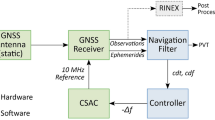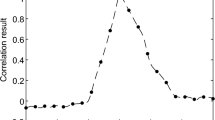Abstract
Single-frequency GNSS RTK is a promising technology in the popularization application due to its relative low expense compared to multi-frequency RTK. Owing to the incapability of forming between-frequency combination and the relatively poor quality of single-frequency receivers, particularly for low-cost receivers, the cycle slip estimation in single frequency is a significant challenge. We propose a new efficient method for real-time single-frequency cycle slip estimation by imposing position-based polynomial constraint based on a fact that the motion of vehicle often obeys a low-order polynomial over a short period. The key is to precisely model the motion kinematics by means of a low-order polynomial fitting of several historical epochs. With the constraint of positional polynomial, the estimation of cycle slips can be significantly improved. To evaluate the feasibility and reliability of this method, a variety of cycle slip situations are tested by comparing with two traditional methods, i.e., the measurement-based polynomial fitting and the triple-differenced residual-based method. The results show that the new method can achieve better results than two traditional methods.




















Similar content being viewed by others
References
Baarda W (1968) A testing procedure for use in geodetic networks. Publications on geodesy. Technical report, vol 2, no 5, Netherlands Geodetic Commission, Delft
Baselga S (2011) Nonexistence of rigorous tests for multiple outlier detection in least-squares adjustment. J Surv Eng 137(3):109–112
Blewitt G (1990) An automatic editing algorithm for GPS data. Geophys Res Lett 17(3):199–202
Carcanague S (2012) Real-time geometry-based cycle slip resolution technique for single-frequency PPP and RTK. In: Proceedings of the ION GNSS 2012, Nashville, Tennessee, USA, 17–21 Sept, 1136–1148
Chang X, Yang X, Zhou T (2005) MLAMBDA: a modified LAMBDA method for integer least-squares estimation. J Geod 79:552–565
Chen D, Ye S, Zhou W, Liu Y, Jiang P, Tang W, Yuan B, Zhao L (2016) A double-differenced cycle slip detection and repair method for GNSS CORS network. GPS Solut 20(3):439–450
Dach R, Hugentobler U, Fridez P, Meindl M (2007) Bernese GPS software version 5.0. Astronomical Institute, University of Bern, 640, 114
Euler HJ, Schaffrin B (1991) On a measure for the discernibility between different ambiguity solutions in the static-kinematic GPS-mode. In: IAG Symposia no. 107, kinematic systems in geodesy, surveying, and remote sensing. Springer, New York, pp 285–295
Freda P, Angrisano A, Gaglione S, Troisi S (2015) Time-differenced carrier phases technique for precise GNSS velocity estimation. GPS Solut 19(2):335–341
Han S (1997) Quality control issues relating to instantaneous ambiguity resolution for real time GPS kinematic positioning. J Geod 71:351–361
Hawkins DM (1980) Identification of outliers. Chapman & Hall, London
Hofmann-Wellenhof B, Lichtenegger H, Wasle E (2007) GNSS-global navigation satellite systems: GPS, GLONASS, Galileo, and more. Springer, Berlin
Kamimura M, Tomita R, Nagano T, Chabata A, Kubo Y (2011) Detection of cycle slips and multipath in GNSS RTK precise point positioning. In: Proceedings of the ION GNSS 2011, pp 1056–1067
Kim Y, Song J, Kee C, Park B (2015) GPS cycle slip detection considering satellite geometry based on TDCP/INS integrated navigation. Sensors 15(10):25336–25365
Kirkko-Jaakkola M, Traugott J, Odijk D, Collin J, Sachs G, Holzapfel F (2009) A RIAM approach to GNSS outlier and cycle slip detection using L1 carrier phase time-differences. In: Proceedings of the 2009 IEEE workshop on signal processing systems (SiPS), Tampere Finland, pp 273–278
Koch K (1999) Parameter estimation and hypothesis testing in linear models, 2nd edn. Springer, Berlin
Lacy MCD, Reguzzoni M, Sansò F, Venuti G (2008) The Bayesian detection of discontinuities in a polynomial regression and its application to the cycle-slip problem. J Geod 82(9):527–542
Lacy MCD, Reguzzoni M, Sansò F (2012) Real-time cycle slip detection in triple-frequency GNSS. GPS Solut 16(3):353–362
Lee HK, Wang J, Park WY, Rizos C (2003) Carrier phase processing issues for high accuracy integrated GPS/Pseudolite/INS systems. In: Proceedings of the 11th IAIN world congress, Berlin, Germany, paper 252
Leick A, Rapoport L, Tatarnikov D (2015) GPS satellite surveying, 4th edn. Wiley, New York
Li B, Teunissen PJG (2014) GNSS antenna array-aided CORS ambiguity resolution. J Geod 88(4):363–376
Li P, Zhang X (2014) Integrating GPS and GLONASS to accelerate convergence and initialization times of precise point positioning. GPS Solut 18(3):461–471
Li X, Zhang X, Ge M (2011) Regional reference network augmented precise point positioning for instantaneous ambiguity resolution. J Geod 85(3):151–158
Li B, Shen Y, Feng Y, Gao W, Yang L (2014) GNSS ambiguity resolution with controllable failure rate for long baseline network RTK. J Geod 88:99–112
Li B, Qin Y, Li Z, Lou L (2016) Undifferenced cycle slip estimation of triple-frequency BeiDou signals with ionosphere prediction. Mar Geod 39(5):348–365
Li B, Zhang L, Verhagen S (2017) Impacts of BeiDou stochastic model on reliability: overall test, w-test and minimal detectable bias. GPS Solut 21:1095–1112
Li B, Qin Y, Liu T, Lou L (2019) Geometry-based cycle slip and data gap repair for multi-GNSS and multi-frequency observations. J Geod 93:399–417
Lin S, Yu FC (2013) Cycle slips detection algorithm for low cost single frequency GPS RTK positioning. Surv Rev 45(330):206–214
Lipp A, Gu X (1994) Cycle slip detection and repair in integrated navigation systems. In: Proceedings of the IEEE PLANS94, pp 681–688
Liu Z (2011) A new automated cycle slip detection and repair method for a single dual-frequency GPS receiver. J Geod 85(3):171–183
Neyman J, Pearson ES (1933) On the problem of the most efficient tests of statistical hypotheses. Philos Trans R Soc Lond Ser A Contain Pap Math Phys Character 231:289–337
Realini E, Reguzzoni M (2013) goGPS: open source software for enhancing the accuracy of low-cost receivers by single-frequency relative kinematic positioning. Meas Sci Technol 24(11):115010
Takasu T, Yasuda A (2008) Cycle slip detection and fixing by MEMS-IMU/GPS integration for mobile environment RTK-GPS. In: Proceedings of the ION GNSS 2008, Institute of Navigation, Savannah, GA, USA, 16–19 Sept, pp 1619–6471
Teunissen PJG (1995) The least-squares ambiguity decorrelation adjustment: a method for fast GPS integer ambiguity estimation. J Geod 70(1–2):65–82
Teunissen PJG (1998) Minimal detectable biases of GPS data. J Geod 72:236–244
Teunissen PJG (2002) Quality control in integrated navigation systems. IEEE Aerosp Electron Syst Mag 5(7):35–41
Teunissen PJG (2006) Testing theory: an introduction, 2nd edn. Delft University Press, Delft
Teunissen PJG, Verhagen S (2007) On GNSS ambiguity acceptance tests. In: Proceedings of IGNSS symposium, Sydney, pp 1–13
Verhagen S, Li B (2012) LAMBDA software package: matlab implementation, version 3.0. Delft University of Technology and Curtin University, Perth
Verhagen S, Teunissen PJG (2013) The ratio test for future GNSS ambiguity resolution. GPS Solut 17(4):535–548
Wei M, Schwarz KP (1995) Fast ambiguity resolution using an integer nonlinear programming method. ION GPS-1995, Palm Springs CA, 1101–1110
Xu G (2007) GPS: theory, algorithms and applications, 2nd edn. Springer, Berlin
Xu P, Shi C, Liu J (2012) Integer estimation methods for GPS ambiguity resolution: an applications oriented review and improvement. Surv Rev 44(324):59–71
Yang L, Wang J, Knight NL, Shen Y (2013) Outlier separability analysis with a multiple alternative hypotheses test. J Geod 87(6):591–604
Ye S, Liu Y, Song W, Lou Y, Yi W, Zhang R, Jiang P, Xiang Y (2016) A cycle slip fixing method with GPS + GLONASS observations in real-time kinematic PPP. GPS Solut 20(1):101–110
Zangeneh-Nejad F, Amiri-Simkooei AR, Sharifi MA, Asgari J (2017) Cycle slip detection and repair of undifferenced single-frequency GPS carrier phase observations. GPS Solut 21:1593–1603
Zhang X, Li P (2016) Benefits of the third frequency signal on cycle slip correction. GPS Solut 20(3):1–10
Zhang X, Guo F, Zhou P (2014) Improved precise point positioning in the presence of ionospheric scintillation. GPS Solut 18(1):51–60
Zhao Q, Sun B, Dai Z, Hu Z, Shi C, Liu J (2015) Real-time detection and repair of cycle slips in triple-frequency GNSS measurements. GPS Solut 19(3):381–391
Zhou Z, Li B (2015) GNSS windowing navigation with adaptively constructed dynamic model. GPS Solut 19(1):37–48
Zhou Z, Shen Y, Li B (2010) A windowing-recursive approach for GPS real-time kinematic positioning. GPS Solut 14(4):365–373
Acknowledgements
This study is sponsored by National Natural Science Foundation of China (41874030, 41622401 and 41574023), the National Key Research and Development Program of China (2016YFB0501802), the Technology Innovation Action Plan of Shanghai Science and Technology Committee (18511101801) and the Fundamental Research Funds for the Central Universities.
Author information
Authors and Affiliations
Corresponding author
Rights and permissions
About this article
Cite this article
Li, B., Liu, T., Nie, L. et al. Single-frequency GNSS cycle slip estimation with positional polynomial constraint. J Geod 93, 1781–1803 (2019). https://doi.org/10.1007/s00190-019-01281-7
Received:
Accepted:
Published:
Issue Date:
DOI: https://doi.org/10.1007/s00190-019-01281-7




